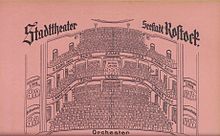Rostock City Theater (1895–1942)
The Rostock City Theater was the largest theater in the Hanseatic City of Rostock from its completion in 1895 until its destruction in 1942. The theater stood at the point where the main building of the Ostsee-Zeitung is today, in the Steintor suburb opposite the medieval Steintor , between Lindenstrasse and Ernst-Barlach-Strasse (formerly Neue Wallstrasse).
history
After Rostock's old city theater was destroyed by fire in 1880, the city announced an architecture competition in 1893 among the architects Becker & Schlueter (Berlin), Seeling (Berlin) and Semper (Hamburg), from which Prof. Heinrich Seeling emerged as the winner. On January 3, 1894, the city council commissioned the building with the building. The time for the construction of the building in the neo-renaissance style was 15 months, the construction costs amounted to about 600,000 marks . The largest part of this amount came from donations from Rostock citizens , but also from legates of Rostock citizens. The theater was inaugurated on October 5, 1895.
In 1938 changes were made to the building again, the auditorium and the foyer were to be redesigned and the orchestra room expanded. The architects Friedrich Lipp and Werry Roth from Berlin were commissioned to do this. It was built from April to August 1938.
Reopened the house on September 1, 1938, the was Tannhauser by Richard Wagner . In this context it should be mentioned that Rostock was also called the “Bayreuth of the North” at this time.
When Rostock was bombed in World War II, the theater building was also hit. It was destroyed on the night of April 24th to 25th, 1942: it burned down completely. The ruins were blown up on August 14, 1948.
Details
Initially, the building had 949 seats: 421 in the stalls, 154 in the first tier, 160 in the second, 240 in the third. In the second tier there was also standing room for 24. Another 40 in the third tier. When the auditorium was redesigned in 1938, the third tier was canceled. There were still 882 places left: 432 in the stalls, 161 in the first and 289 in the second tier.
There were also guest appearances in the Rostock City Theater, including in May 1925 by the Milan Opera- Stagione , which performed the Barber of Seville and Aida .
literature
- Friends and sponsors Volkstheater Rostock e. V .; Volkstheater Rostock (ed.): Buildings and projects for the theater of the Hanseatic City of Rostock 1895–2005 . Rostock 2005. ( PDF 3.73 MB )
Web links
Europeana: City Theater in Rostock
Coordinates: 54 ° 5 ′ 7 ″ N , 12 ° 8 ′ 30 ″ E


